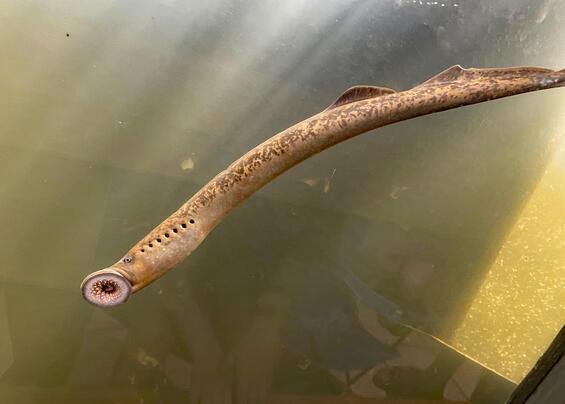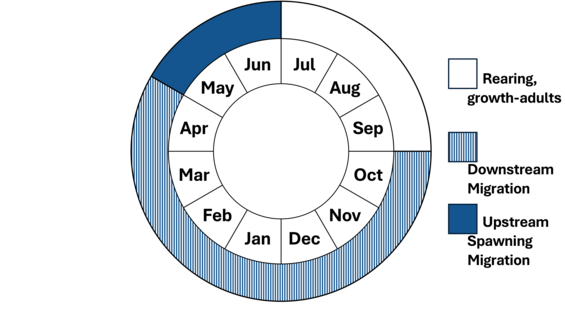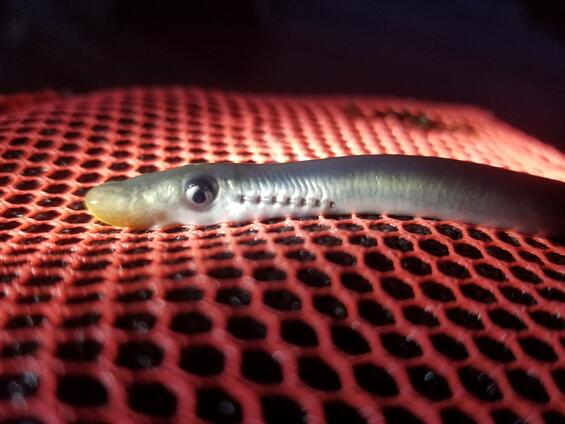- Scientific name: Petromyzon marinus
- Species of Greatest Conservation Need (MA State Wildlife Action Plan)
Description

Sea lamprey (Petromyzon marinus)
The sea lamprey is a primitive, eel-like fish that lacks jaws, scales, paired fins, and bones. It has a cartilaginous skeleton, one nostril between the eyes, and seven pairs of pore-like gill openings. Adults are usually greater than 61 cm (24 in) in total length. Sea lampreys are anadromous, meaning they spend most of their lives in marine waters and migrate to freshwater rivers to spawn. Adults are parasitic, attaching themselves to a variety of oceanic species and feeding on their blood and body fluids.
After two years at sea, the adults enter fresh water in the spring and spawn in July. Sea lamprey are semelparous, meaning after spawning, the adults die. Juveniles, eyeless larva known as ammocoetes, burrow into the stream bottom and live as filter feeders for four to five years. Eventually ammocoetes transform into young adults that migrate to the ocean.
Life cycle and behavior

Adult sea lampreys spend about 2 years in the ocean before returning to freshwater streams to spawn. While in the ocean, they feed parasitically on a variety of fishes using their suction-disk mouth openings, extracting fluids from host fish. When they are mature, they undergo annual spring spawning migrations to freshwater rivers, where they find suitable river and stream locations, typically with gravel and rocky substrates. Spawning occurs in May and June when stream temperatures reach 10-15 °C (50-59 °F). Sea lamprey use their disk mouths to move and construct rock and gravel nests. Females then attach to rocks upstream of the nests and release 124,000-305,000 eggs. Sea lamprey then die after spawning. Eggs hatch in about 2 weeks, and young ammocoetes drift downstream and burrow in river sediment for 4-5 years where they filter feed before maturing and migrating to the ocean.
Population status

Juvenile sea lamprey collected in the Connecticut River during a survey on 10/22/2018.
Historically, sea lamprey inhabited most rivers and streams in Massachusetts, while today, their populations are restricted to the Connecticut and Merrimack Rivers, with small remnant runs in several other coastal rivers. Populations have been significantly reduced from historical abundances since the construction of dams, particularly main-stem dams in large rivers (Connecticut and Merrimack) during the early 1800s. Populations remain low but somewhat stable after improvements to fish passage structures at main-stem dams.
Distribution and abundance
Sea lampreys are common in Massachusetts and enter several coastal streams and the Connecticut and Merrimack Rivers. Records of sea lamprey passage at the Holyoke Dam on the Connecticut River demonstrate that current abundance is roughly 50% of the historic numbers.
Habitat
Sea lamprey live in sediment in river bottoms for their first 4-5 years, then they migrate to the ocean where they spend about 2 years feeding and growing. They then migrate to freshwater rivers and streams where they spawn. Primary habitats in Massachusetts are the Connecticut and Merrimack Rivers. Throughout the United States, sea lamprey range from Maine to Florida, inhabiting coastal rivers.
Sea lamprey have been introduced to non-native rivers and lakes, such as the Great Lakes, where they have caused damage to commercial and recreational fisheries. Thus, while they are considered an invasive and problematic species in the Great Lakes, they are priorities for restoration in their native Atlantic Coast rivers.
Healthy habitats are vital for supporting native wildlife and plants. Explore habitats and learn about conservation and restoration in Massachusetts.
Threats
Like other anadromous fish, sea lamprey populations have been reduced or eliminated in some areas by damming and pollution. The factors which have caused an apparent decline in this species are most likely due to loss of spawning and rearing habitat, because of dams.
Conservation
Restoring and protecting access to sea lamprey spawning habitat will help the conservation of the species.
Survey and monitoring
Sea lamprey are collected during standard fisheries surveys, and upstream passage numbers are monitored at main-stem dams with Federal Energy Regulatory Commission (FERC) - regulated hydropower facilities.
Management
The Connecticut River Migratory Fish Restoration Cooperative (formerly known as Connecticut River Atlantic Salmon Commission) has adopted a Connecticut River Anadromous sea lamprey Management Plan which discusses habitat access, monitoring, life history, population status, and strategies for restoration.
Research needs
A better understanding of spawning habitat needs and targeted dam removals or upstream passage needs may aid in the restoration of this species.
References
This species description was adapted, with permission, from:
Karsten E. Hartel, David B. Halliwell, and Alan E. Launer. 2002. Inland Fishes of Massachusetts. Massachusetts Audubon Society, Lincoln, Massachusetts.
Contact
| Date published: | April 11, 2025 |
|---|